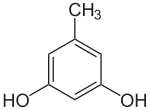- Orcinol
-
Orcinol[1]  5-Methylbenzene-1,3-diolOther names5-Methylresorcinol
5-Methylbenzene-1,3-diolOther names5-Methylresorcinol
3,5-Toluenediol
Orcin
5-Methyl-1,3-benzenediol
3,5-DihydroxytolueneIdentifiers CAS number 504-15-4 
PubChem 10436 ChemSpider 13839080 
UNII 534PMB3438 
Jmol-3D images Image 1 - CC1=CC(=CC(=C1)O)O
Properties Molecular formula C7H8O2 Molar mass 124.13 g/mol (anhydr.) Appearance Crystalline Melting point 110.0-110.5 °C – 107 °C (anhydr.)
Boiling point 290 °C (289.5 °C)
Solubility in water Miscible  (verify) (what is:
(verify) (what is:  /
/ ?)
?)
Except where noted otherwise, data are given for materials in their standard state (at 25 °C, 100 kPa)Infobox references Orcinol is a natural phenolic organic compound that occurs in many species of lichens[2] including Rocella tinctoria and Lecanora. It can be formed by fusing extract of aloes with potash.
It is used in the production of the dye orcein and as a reagent in some chemical tests for pentoses, such as Bial's Test. It may be synthesized from toluene; more interesting is its production when acetone dicarboxylic ester is condensed with the aid of sodium. It crystallizes in colorless prisms with one molecule of water, which redden on exposure to air. Ferric chloride gives a bluish-violet coloration with the aqueous solution. Unlike resorcinol it does not give a fluorescein with phthalic anhydride. Oxidation of the ammoniacal solution gives orcein, C28H24N2O7, the chief constituent of the natural dye archil. Homo-pyrocatechin is an isomer (CH1: OH: OH= 1 3 :4), found as its methyl ether (creosol) in beech-wood tar.
See also
References
- ^ Merck Index, 11th Edition, 6819.
- ^ Robiquet: „Essai analytique des lichens de l’orseille“, Annales de chimie et de physique, 1829, 42, p. 236–257.
 This article incorporates text from a publication now in the public domain: Chisholm, Hugh, ed (1911). Encyclopædia Britannica (11th ed.). Cambridge University Press.
This article incorporates text from a publication now in the public domain: Chisholm, Hugh, ed (1911). Encyclopædia Britannica (11th ed.). Cambridge University Press.
This article about a natural phenol is a stub. You can help Wikipedia by expanding it.

